Biology Chapter 1 The Fundamental Unit Of Life
If you ever come across a brick wall being constructed, then you can see that bricks are the basic building blocks of a wall. Similarly, cells are the fundamental units of your body. In simple definition, cells are sacs of fluid enveloped by membranes with chemicals and organelles embedded inside the fluid.
Though an organism possesses few other structures that are smaller than a cell and yet, however, cell is considered to be the smallest part of an organism. Robert Hooke (1665) discovered the cell, while studying a thin slice of cork through a crude microscope. He observed that cork resembled the structure of a honeycomb having many small compartments.
He called these little compartments as ‘cells’ (in Latin, ‘cellula’, which means ‘a little room’). His discovery was published in a book ‘Micrographia’. The ability to produce energy, synthesize hormones, transmit hereditary factors are examples of a few events that take place within the tiny building blocks of life called ‘Cells’.
Read and Learn More: NEET Foundation Notes

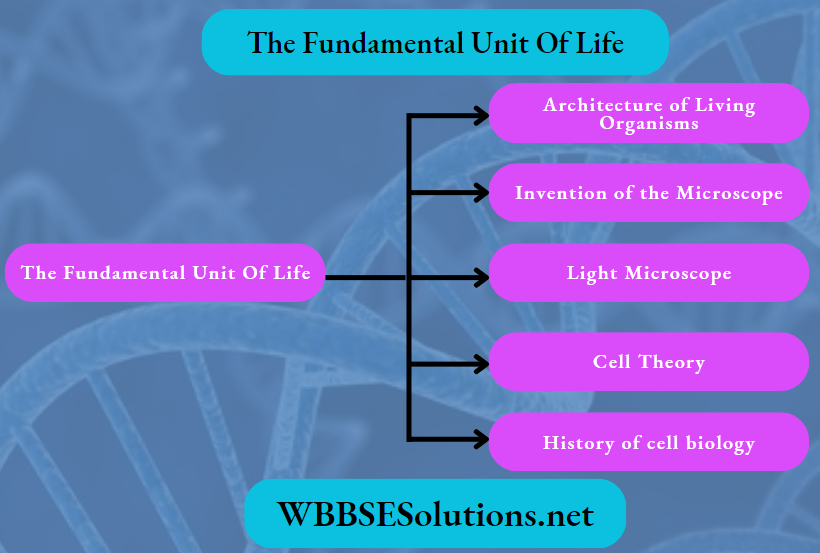
Chapter 1 The Fundamental Unit Of Life Architecture of Living Organisms
When you observe the inner layer of an onion by dropping iodine solution followed by a cover slip under high powers of a compound microscope. The structures of inner layer look similar to each other. Together they form a big structure like an onion bulb. Hence, we concluded that any organism despite different sizes have similar small structures visible under microscope.
The small structure that we observe are the basic structural and functional unit of onion bulbs. There are also single cells that live on their own, such as Amoeba, Chlamydomonas, Paramecium, and Bacteria. These organisms are called unicellular organisms. Many cells group together in a single body to form multicellular organisms like fungi.
Invention of the Microscope
Invention of the microscope was a milestone with regard to learning the delicate details of internal arrangement of the cell. Cells are microscopic structures not visible to human eyes. Anton van Leeuwenhoek is the father of microbiology who in the late 17th century became the first man to make and use a real microscope.
Ordinary compound microscope is an optical instrument that consists of two convex lenses of short focal lengths. This microscope can magnify the image of a tiny object up to 1000 times. Electron microscope uses electron beams to illuminate a specimen object and create a magnified image.
It magnifies to over 2,00,000 times the magnification of an ordinary compound microscope. The variations between the working of a light microscope and electron microscope is discussed.
Differences between light microscope and electron microscope
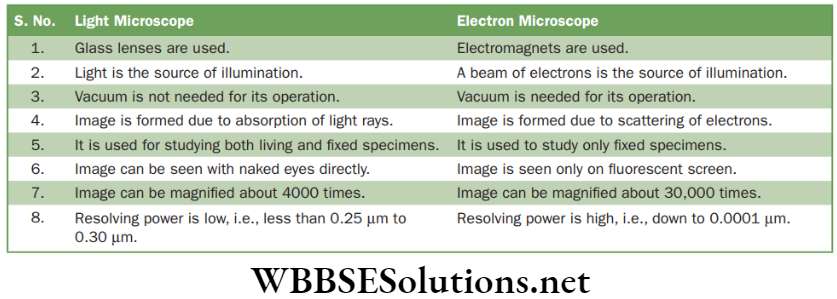
Cell Theory
Jacob Matthias Schleiden (1838), a German botanist and Theodor Schwann (1839), a German zoologist stated that cells are the fundamental and building blocks of all plants and animals. Their discoveries led to the formulation of the cell theory. They postulated that all animals and plants are made up of cell.
History of cell biology

Rudolf Virchow (1855) further refined the cell theory and gave the idea that all cells arise from pre-existing cells.
The main postulates of the modern cell theory are as follows.
- All organisms are made up of one or more cells and cell products.
- All metabolic reactions occur in cells. Hence, cells are the structural and functional units of life.
- All cells arise from pre-existing cells, as an animal gives birth only to an animal and a plant gives rise only to a plant.
- An organism begins its life as a single cell.
- Virus is an exception of this theory.
Chapter 1 The Fundamental Unit Of Life Cell Shape
Living cell has the capacity to perform certain basic functions that are characteristics of all living forms. Depending upon the functions perfomed by cells are of different shapes and sizes. Most plant and animal cells are basically the same when formed.
By the processes of maturation and differentiation, they acquire different forms. Different parts in human body performs different functions. The human body has heart to pump blood and stomach to digest food.
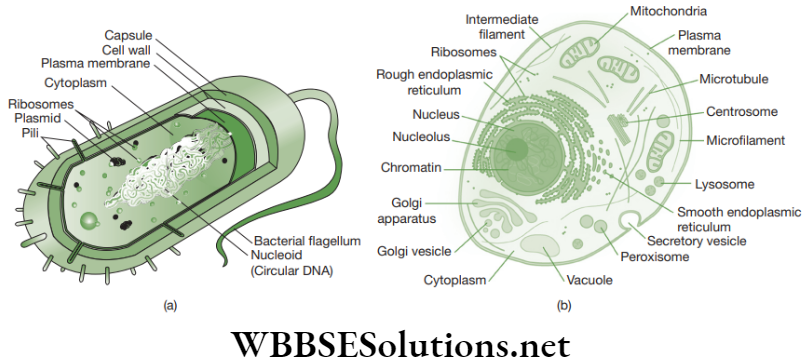
Eukaryotes are organisms with a well-defined membrane bound nucleus and other organelles. Eukaryotic cell is spherical in shape, but ultimately the shape of a cell is governed by the specific function of the cell. The shape of the cell may be variable or fixed.
For example, amoeba changes its shape and white blood cells or leucocytes are spherical in circulating blood, but in other situations they become irregular in shape by producing pseudopodia. Cells have fixed shape in most of the plants and animals.
In unicellular organisms, the cell shape is determined by the hard plasma membrane (for example, Paramecium) and exoskeleton (for example, Elphidium). In multicellular organisms, the cell shape is mainly determined by its functional adaptations, and also by the surface tension, viscosity of the protoplasm, the mechanical pressure exerted by adjacent cells and the presence of a rigid cell wall such as in plant cells.
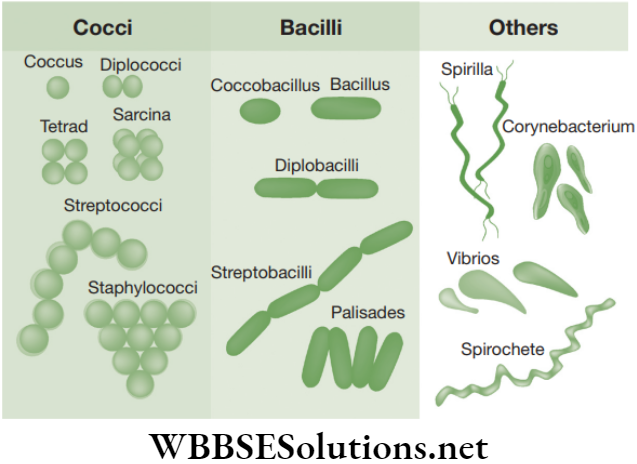
Cell Volume
Cell volume is almost consistent for a specific cell type and it is not dependent on the size of an organism. For example, in a bull, horse and mouse, the kidney and liver cells are almost of the same size. The variation in the total mass of the organ as well as organism is determined by the number and not the volume of the cells.
Cell Number
The number of cells in organisms is related to the size of the organism. Hence, the small-sized organisms have less number of cells as compared to the largesized organism. In most multicellular organisms, the number of cells is not fixed, except a few such as rotifers and nematodes. In human beings, the number of cells present in the body is approximately 100 trillion (1014).
Chapter 1 The Fundamental Unit Of Life Master Your Test Question And Answers
Question 1. Who discovered cells and how?
Answer: Cell was discovered by Robert Hooke in 1665 while studying a thin slice of cork through a crude microscope. He observed that cork resembled the structure of a honeycomb having many small compartments. These compartments were later known as cells.
Question 2. Why cell is called the structural and functional unit of life?
Answer: Cells are called the structural and functional unit of life because all living organisms are made up of cells. These cells carried out specific functions which is important for life processes.
Question 3. Write the main postulates of cell theory. Who propounded the cell theory?
Answer: Rudolf Virchow propounded the concept of cell theory and gave the idea that all cells arise from pre-existing cells. The main postulates of the modern cell theory are as follows.
- All organisms are made up of one or more cells and cell products.
- All metabolic reactions occur in cells. Hence, cells are structural and functional units of life.
- All cells arise from pre-existing cells, as an animal gives birth only to an animal and a plant gives rise only to a plant.
- An organism begins its life as a single cell.
Question 4. Differentiate between prokaryotic and eukaryotic cells.
Answer:
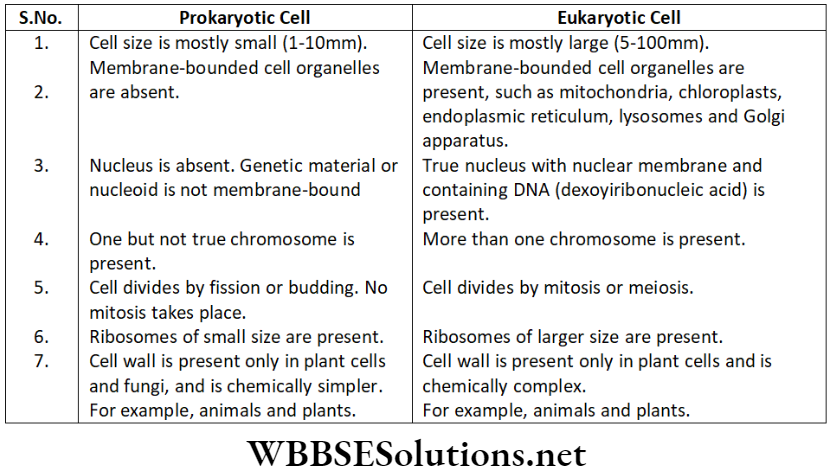
Chapter 1 The Fundamental Unit Of Life Structural Organization of a Cell
Microscopic studies reveal that most cells have the same basic structural architecture. The cells have a jellylike substance called protoplasm bound by a cell membrane. The term protoplasm was coined by Purkinje in 1839. The protoplasm consists of the cytoplasm and a spherical body called nucleus. All the cells possess the following three major functional zones.
- The cell membrane or plasma membrane and the cell wall
- The nucleus
- The cytoplasm
Plasma Membrane
The plasma membrane is the outer boundary of the cell, enveloping the cytoplasm. In the cytoplasm, all the cell organelles and inclusions are embedded. All the cell organelles like mitochondria, chloroplasts, lysosomes, peroxisomes, Golgi apparatus, nucleus and endoplasmic reticulum are enclosed by the unit membrane. In animal cells, the plasma membrane is present in the outermost layer of the cell, whereas in plant cell it is present just beneath the cell wall.
Structure
Plasma membrane is a thin (about 7 nm), delicate, elastic, and selectively permeable membrane. The membrane is almost made up of 75% phospholipids. Also, it consists of proteins, cholesterol and polysaccharides.
Fluid Mosaic Model: S. J. Singer and G. L. Nicolson (1972) proposed a model called the fluid mosaic model to explain the structure of functional cell membranes or plasma membranes. According to this model, the plasma membrane is made up of a double layer of phospholipids.
The plasma membrane allows the movement of only certain substances across it and prevents the rest. Hence, it is selectively permeable. Two kinds of protein molecules float in the fluid phospholipid bilayerand they are explained as follows.
- Intrinsic or integral proteins completely cover the lipid bilayer.
- Extrinsic or peripheral proteins occur either on the outer surface or on the inner surface of the lipid membrane.
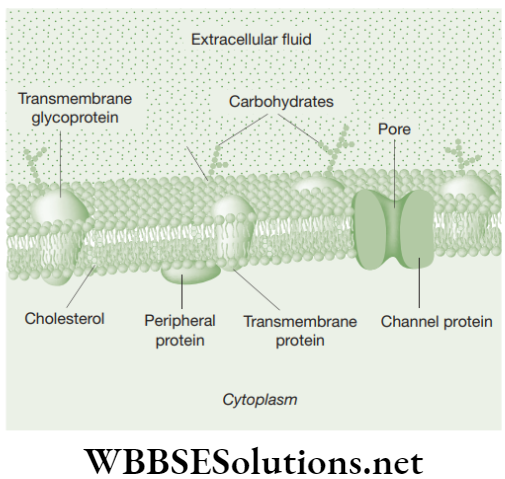
Functions
- Plasma membrane is a selectively permeable membrane, which regulates the entry and exit of the cell contents.
- It performs some physical activities, like diffusion and osmosis for the intake of some substances.
- In addition, some other biological activities like active transport and endocytosis are performed by the plasma membrane.
- The fluid nature of the plasma membrane makes it flexible and enables it to engulf substances or remove wastes by vesicle formation.
- Certain factors present in the plasma membranes play an important role in cell recognition in immune receptors.
Transport of Substances Across the Plasma Membrane
The passage of substances across the cell membrane takes place by three models listed as follows.
- Passive transport
- Active transport
- Bulk transport
Passive Transport
1. Diffusion: Certain substances can easily pass through the plasma membrane by a simple process of diffusion. Diffusion can take place in all states of matter and however, it takes place faster in the gaseous state.
Diffusion is the net movement of solute particles from a region of high concentration to the region of low concentration. When there is a difference of CO2 concentration, inside and outside of a cell, gas moves out of the cell to the external environment, i.e., from the region of its higher concentration to the region of its lower concentration with the help of diffusion process.
Similarly, oxygen (O2) enters the cell by the process of diffusion when the concentration of O2 inside the cell becomes lower such as in Amoeba.
Diffusion is significant to biological systems due to the following reasons.
- Helps in the uniform distribution of substances in the cytoplasm.
- Assists in exchange of gases which is critical to processes, such as respiration and photosynthesis.
- Helps in attracting insects for pollination by spreading the scented chemicals from flowers.
- Helps in diffusion and the nutrient chemicals get absorbed into cells in the intestine of digestive system.
2. Osmosis: Osmosis is the passage of water or solvent from a region of high solvent concentration through a semi-permeable membrane to a region of low solvent concentration. Osmotic pressure is the external pressure needed to be applied so that there is no net movement of solvent across the membrane. Osmosis was first observed by Jean-Antoine Nollet (1748).
Osmosis is a mechanical diffusion process through which cells absorb water without spending any amount of energy. Osmosis is significant to biological systems due to the following reasons:
- Helps in the absorption of water by the roots from the soil.
- Helps in closing and opening of stomata on the leaves.
- Assists in cell-to-cell movement of water.
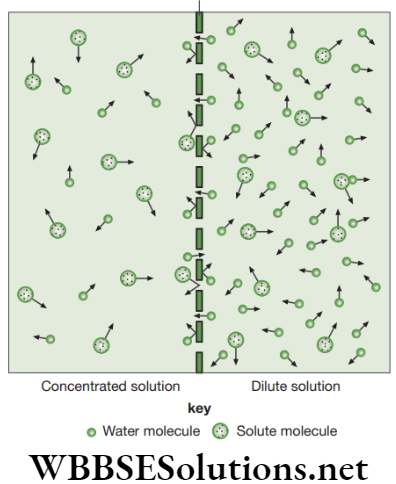
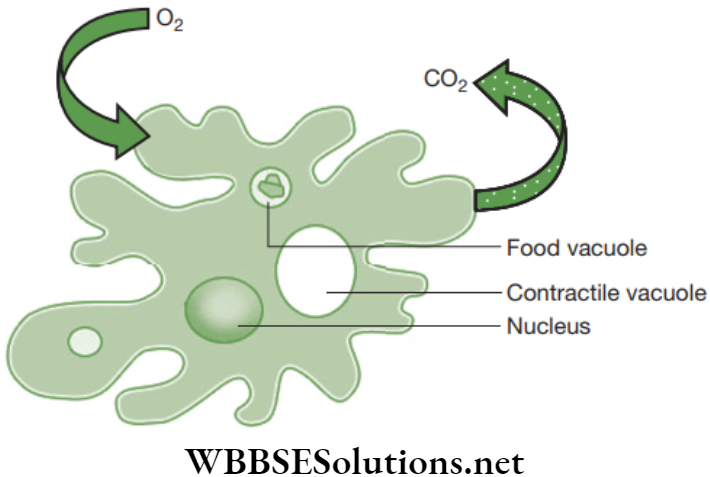
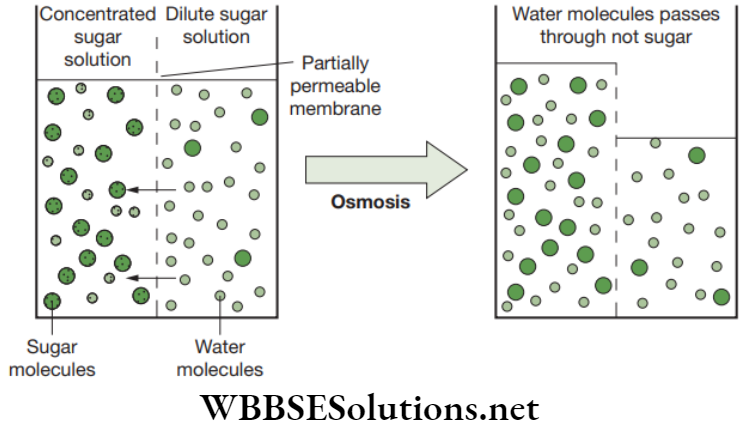
While studying the effects of different solutions on plant and animal cells, three conditions may arise depending upon the tonicity of the solution.
Hypotonic solution: When the medium surrounding the cell has a higher concentration of water (a very dilute solution) as compared to the inside of the cell, the cell will gain water by osmosis. This dilute solution is called hypotonic solution. In this situation, the cell swells up, as more water will enter the cell than leave the cell. These swollen RBC’s may finally burst, i.e., haemolysed.
1. Isotonic solution: When the medium surrounding the cell is of precisely the same water concentration as the cell, there will be no net movement of water across the membrane. This solution is called isotonic solution. For example, Ringer’s solution is an isotonic solution for the animal cells. In this condition, water moves across the plasma membrane in both directions and the amount of water going in is equal to the amount going out. Hence, the cell will retain the same size.
2. Hypertonic solution: When the medium has a lower concentration of water (a very concentrated solution) than the inside of the cell, the cell will lose water by osmosis. This concentrated solution is called hypertonic solution (Fig. 1.7). Here, water moves across the plasma membrane in both directions, but more water leaves the cell than enters the cell. Hence, the cell will shrink. In this condition, the plant cell gets plasmolysed and the animal cell gets crenated.
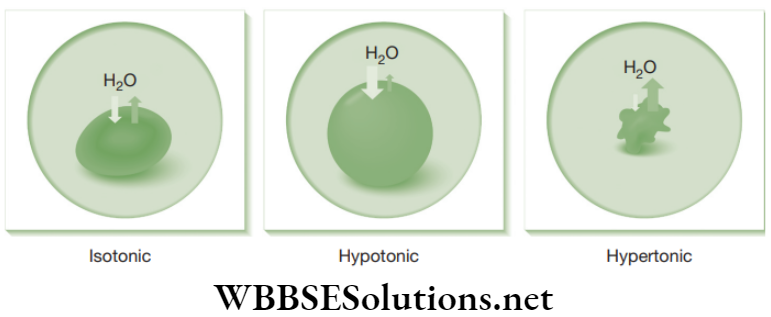
3. Facilitated transport/diffusion: The permease helps a molecule to diffuse through the membrane that it cannot penetrate alone. It promotes movement in a downhill direction only, i.e., in the direction of the concentration gradient and needs no metabolic energy to carry out the transport system. For example, in many animals, the facilitated diffusion helps in the transport of glucose (blood sugar) into the body cells that oxidizes it to get ATP’s.
As the amount of glucose is more in the blood than in the cells that consume it, an inward diffusion takes place. Because glucose is a water-soluble molecule that on its own cannot penetrate the membrane rapidly enough to support the metabolism of various cells, the mediated transport accelerates the inward flow of glucose.
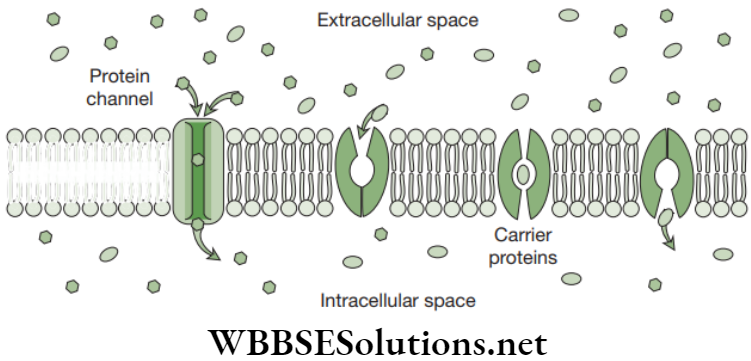
Active Transport
The energy is provided to the system (‘pump’) to transport molecules in a direction opposite to a concentration gradient. It promotes movement in uphill direction, i.e., against the forces of passive diffusion. This involves expenditure of energy from ATP as substances are pumped against the concentration gradient.
The best example of active transport system in all animals is the maintenance of sodium and potassium gradients between cells and the surrounding extracellular fluid. Most of the animal cells need a high internal concentration of potassium ions for protein synthesis by the ribosomes and for some enzymatic activities.
The concentration of potassium ions is about 20–50 times more inside the cell as compared to the outside of the cell. On the other hand, sodium ion concentration is about 10 times more outside the cell as compared to the inside of the cell. Active transport maintains both these ionic gradients by transporting potassium ions into and the cell sodium ions out of the cell.
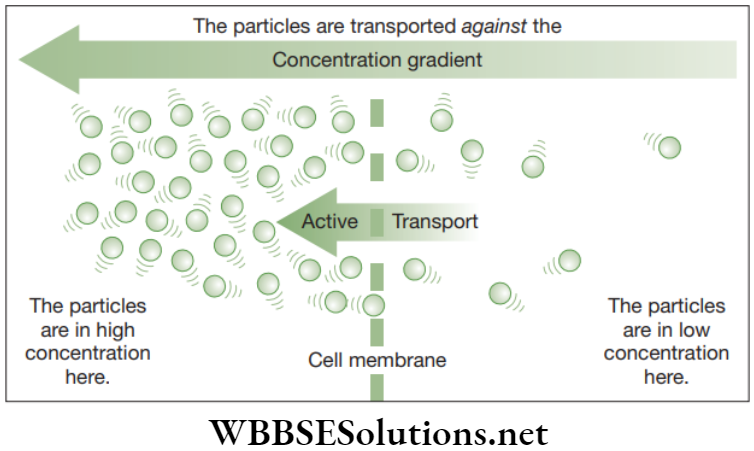
Bulk Transport
Bulk transport involves the movement of macro-nutrients, such as proteins, polysaccharides which can pass only through ruptured plasma membrane. Large molecules generally cross the membrane in bulk by endocytosis and exocytosis.
1. Endocytosis: The process by which material moves into the cell. It is of three types, namely phagocytosis(cell eating), potocytosis (cell drinking) and receptor-mediated endocytosis. All the three processes require energy.
- Phagocytosis: It is the process by which a cell called phagocyte takes in or engulfs or eats other cells or particles. The newly-formed phagosome then fuses with a lysosome whose hydrolytic enzymes digest the ’food’ inside. For example, white blood cells (leucocytes) that engulfs cellular debris and unwanted microbes in the blood. Other phagocytes are also present such as the macrophages found in connective tissue and liver sinusoids.
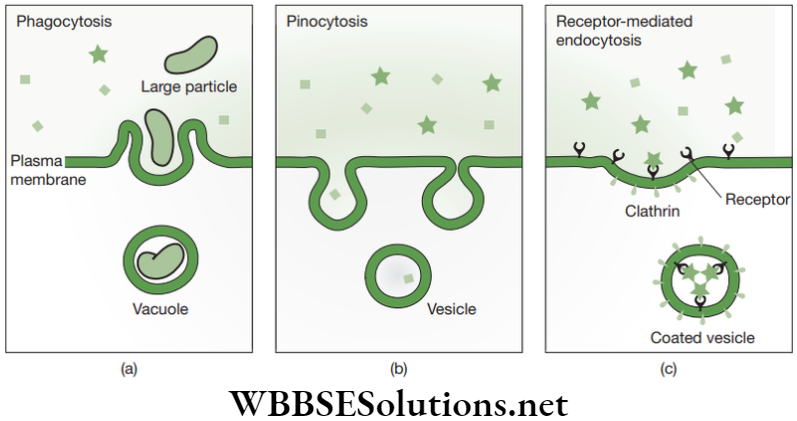
- Pinocytosis: The cell engulfs drops of fluid by pinching in and forming vesicles. Similarly to phagocytosis, pinocytosis is an unspecific process where the cell takes in any of the solutes that are dissolved in the liquid it encloses.
- Receptor-mediated endocytosis: It is a very selective process of importing substances into the cell. In this process, the receptor proteins present on depressed areas of the cell membrane (‘coated pits’) determines this specificity. Coat proteins cover the cytosolic surface of coated pits. The cell will only pick up an extracellular molecule when it binds to its specific receptor protein on the surface of the cell. When binding is done, the coated pit on which the bound receptor protein is situated then pinches in, to produce a coated vesicle. This coated vesicle now fuses with a lysosome to digest the engulfed substance and release it into the cytosol.
2. Exocytosis (Cell vomiting): Exocytosis is the process by which the intracellular vesicles in the cytoplasm fuse with the plasma membrane and release their contents into the surrounding medium.
Exocytosis takes place in many cells for the following purposes.
- Removes undigested material brought inside the cell by phagocytosis.
- Secrete substances like hormones, enzymes, etc.
- Transport a material wholly across a cellular barrier, for example, an immunoglobulin (IgA) or antibody is picked up on one side of the blood vessel wall by phagocytosis, transported across the cell and released by exocytosis.
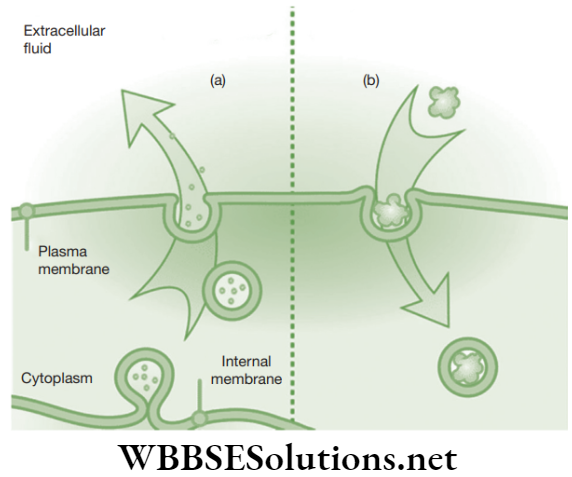
Summary of movement methods across membranes
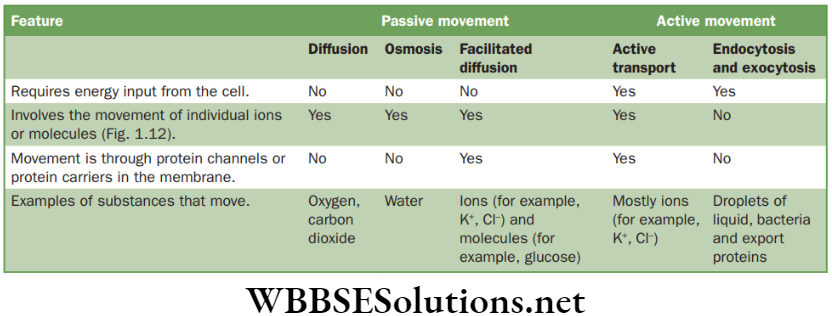
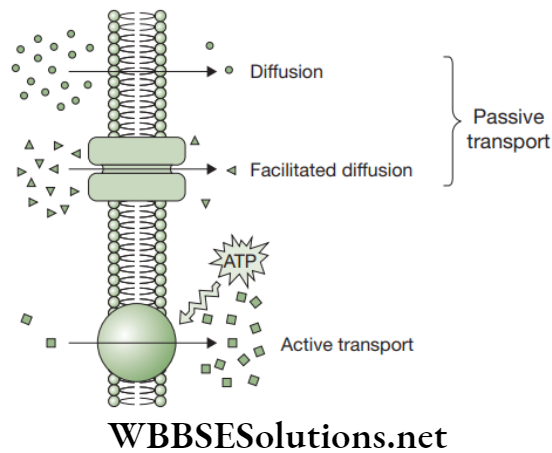
Chapter 1 The Fundamental Unit Of Life Cell Wall
Cell wall is a rigid, non-living and freely permeable layer that lies outside the plasma membrane in plant cells. It protects the cell and its contents and determines the shape of the cell, and prevents desiccation of cells. It consists of a fibrous polysaccharide (carbohydrate) called cellulose.
Thus, the cell wall consists of minute cellulose fibres called microfibrils, which are cemented together by a mixture of polysaccharides. Each microfibril consists of numerous cellulose molecules bound together by pectins and hemicellulose.
Structure of Plant Cell Wall
Basically, the plant cell well consists of three layers and it is briefly explained as follows.
- Primary cell wall: A thin, flexible and extensible layer formed when the cell is growing. It provides the strength and flexibility required to allow the growth of cells.
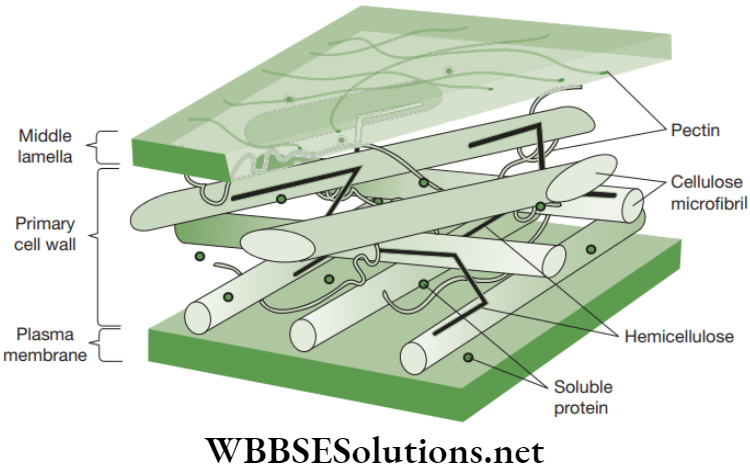
- Secondary cell wall: A thick layer is formed inside the primary cell wall when the cell is fully grown. This layer is not found in all types of cells. Only some cells, such as the conducting cells in xylem have secondary wall consisting lignin that strengthens and protects the wall from water.
- Middle lamella: An outermost layer rich in pectins forms the interface between adjacent plant cells and cements them together.
Functions of a Cell Wall
- Cell wall makes the plant cell turgid. When water enters the vacuole through osmosis, the plant cell expands. The cell wall provides strength to the cell by providing turgidity to resist this expansion.
- Cell wall provides mechanical strength to the cell with the help of cellulose microfibrils. In xylem, lignin is present to provide additional strength. In collenchyma cells, extra amount of cellulose is present in the cell wall which increases the mechanical support.
- Cell wall is freely permeable to solvent and materials in solution.
- Cell wall consists of narrow pores known as pits through which very fine strands of cytoplasm known as plasmodesmata are able to pass. These intercellular connections permit the exchange of substances between the living cell contents.
- Middle lamella is a pectin layer that cements the cell walls of two adjoining cells together, which gives stability to the plants and also permits the plants to form plasmodesmata between cells. This layer is made up of calcium and magnesium pectates. This is the first layer that is formed and deposited during cytokinesis.
Plasmolysis
The phenomenon in which a living plant cell loses water through osmosis leading to shrinkage or contraction of the protoplasm away from the cell wall is called plasmolysis.
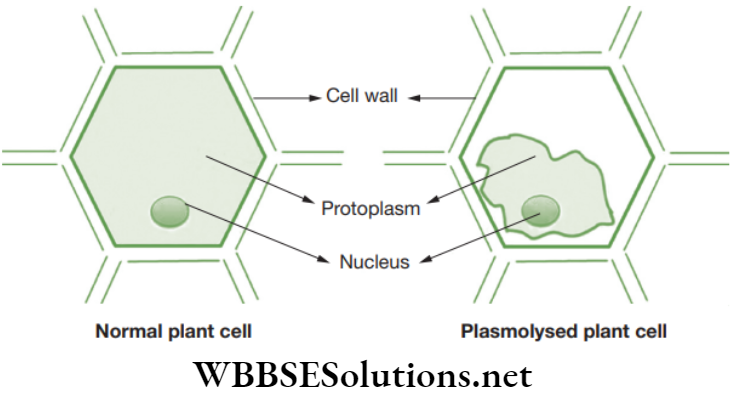
Chapter 1 The Fundamental Unit Of Life Track Your Learning Questions and Answers
Question 1. A science student was viewing a rose plant cell through an electron microscope, where the student observes the presence of a hard rigid wall and a very thin delicate wall in the cell enclosing the cytoplasm.
How can we call that thin delicate wall?
- Cell wall
- Middle lamella
- Plasma membrane
- Nuclear membrane
Answer. 3. Plasma membrane
Question 2. Gaseous exchange in amoeba takes place through
- Osmosis
- Photosynthesis
- Diffusion
- Exosmosis
Answer. 3. Diffusion
Question 3. In ______, permease assists a molecule to diffuse through the membrane that it cannot penetrate alone.
- Facilitated transport or diffusion
- Active diffusion
- Osmosis
- Pinocytosis
Answer. 1. Facilitated transport or diffusion
Question 4. Name the ‘energy currency of the cell’.
- GTP
- ATP
- DTP
- ADP
Answer. 2. ATP
Question 5. Phagocytosis is
- Cell eating
- Cell drinking
- Cell death
- Cell vomiting
Answer. 1. Cell eating
Question 6. Pinocytosis is
- Cell eating
- Cell drinking
- Cell death
- Cell vomiting
Answer. 2. Cell drinking
Question 7. Exocytosis is
- Cell eating
- Cell drinking
- Cell death
- Cell vomiting
Answer. 4. Cell vomiting
Question 8. The cell wall consists of minute cellulose fibres called
- Microfibrils
- Microsomes
- Microtubules
- Microns
Answer. 1. Microfibrils
Chapter 1 The Fundamental Unit Of Life Nucleus (‘Brain of the Cell’)
The nucleus is membrane-bounded, centrally-located, spherical structure present in the eukaryotic cell. There are two nuclear membranes forming a nuclear envelope. There is a space between two nuclear membranes, which is connected to a system of membranes known as endoplasmic reticulum (ER).
The nuclear envelope makes the nucleus distinct from the cytoplasm. It also contains many pores called nuclear poresand it consists of the liquid ground substance called nucleoplasm. Nuclear pores permit the transfer of substances between the nucleoplasm and the cytoplasm.
The nucleoplasm consists of the nucleolus and chromatin material. The nucleolus is not bounded by any membrane and it is rich in protein and RNA (ribonucleic acid), and thus, it acts as a site for ribosome production. Ribosomes help in protein synthesis in the cytoplasm.
The chromatin is a thin, thread-like entangled mass of chromosome material and it consists of the genetic material DNA and proteins (i.e., histones). The chromatin is formed of repeating subunits called nucleosomes. Each nucleosome has a DNA molecule coiled around a disc of histones.
DNA is considered to be the blueprint of life as it contains all the required information for the cell to function, to grow and to reproduce. Genes are the discrete segments of DNA. During cell division, the chromatin material gets condensed into two or more thick ribbon-like chromosomes.
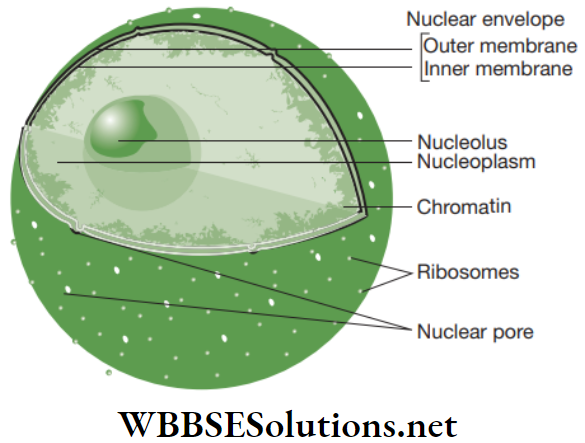
Functions of Nucleus
- Nucleus controls all metabolic activity of the cell.
- Nucleus regulates the cell cycle.
- Nucleus controls the transmission of hereditary characteristics from the parent to offspring.
Chapter 1 The Fundamental Unit Of Life Master Your Test Question And Answers
Question 1. What is chromatin?
Answer: The chromatin is a thin, thread-like entangled mass of chromosome material and it consists of the genetic material DNA and proteins (i.e., histones). The chromatin is formed of repeating subunits called nucleosomes.
Question 2. What is plasmodesmata?
Answer: Cell wall consists of narrow pores known as pits through which very fine strands of cytoplasm known as plasmodesmata.
Question 3. Which organelle is known as the powerhouse of the cell and why?
Answer: Mitochondria is known as the powerhouse of cells because the energy required for various chemical activities needed to support life is released by mitochondria in the form of ATP (Adenosine triphosphate) molecules.
Question 4. Where do the lipids and proteins constituting the cell membrane gets synthesized?
Answer: Lipids are synthesized in smooth endoplasmic reticulum and the proteins are synthesized in endoplasmic reticulum.
Question 5. What are nuclear pores?
Answer: The nuclear envelope makes the nucleus distinct from cytoplasm. It also contains many pores called nuclear pores and it consists of the liquid ground substance called nucleoplasm.
Question 6. What are the functions of nucleus?
Answer:
- Nucleus controls all metabolic activity of the cell.
- Nucleus regulates the cell cycle.
- Nucleus controls the transmission of hereditary characteristics from the parent to offspring.
Chapter 1 The Fundamental Unit Of Life Track Your Learning Questions and Answers
Question 1. Name the ’protein factories of a cell’.
- Peroxisomes
- Lysosomes
- Ribosomes
- Nucleus
Answer. 3. Ribosomes
Question 2. Genes are the discrete segments of
- RNA
- ATP
- mRNA
- DNA
Answer. 4. DNA
Question 3. ______ provides a specific shape to the chromosomes owing to its position.
- Centromere
- Centriole
- Peroxisome
- Oxysome
Answer. 1. Centromere
Question 4. Human beings have ______ pairs of chromosomes.
- 21
- 22
- 23
- 46
Answer. 3. 23
Question 5. Diffusion is fastest in
- Solid phase
- Liquid phase
- Semi-solid phase
- Gaseous phase
Answer. 4. Gaseous phase
Question 6. What will happen when a cell is kept in an isotonic solution?
- Shape of the cell changes.
- Size of the cell remains the same.
- Will shrink
- Will swell
Answer. 2. Size of the cell remains the same.
Question 7. The process of withdrawal of water from a cell through osmosis is called
- Endosmosis
- Exosmosis
- Both (a) and (b)
- None of these
Answer. 2. Exosmosis
Question 8. When exosmosis occurs in a plant cell, it is
- Plasmolysed
- Re-plasmolysed
- Non-plasmolysed
- None of these
Answer. 1. Plasmolysed
Question 9. Transport of substances across the plasmalemma against the concentration gradient is
- Active transport
- Passive transport
- Bulk transport
- All of these
Answer. 1. Active transport
Question 10. Unicellular freshwater animals and most plant cells tend to gain water through the process of
- Diffusion
- Osmosis
- Imbibition
- Facilitated diffusion
Answer. 3. Imbibition
Question 11. Fluid mosaic model of the plasma membrane was given by
- Schleiden and Schwann
- Singer and Nicolson
- Knoll and Ruska
- Huxley
Answer. 2. Singer and Nicolson
Question 12. The phenomenon by which protoplast of a cell shrinks from the wall is called
- Osmosis
- Plasmolysis
- Diffusion
- Glycolysis
Answer. 2. Plasmolysis
Chapter 1 The Fundamental Unit Of Life Cytoplasm
Cytoplasm is the region of the cell located between the plasma membrane and nuclear envelope. Cytoplasm is a living, colourless, semi-liquid and homogenous substance. It occupies a major part of the cell and it is constantly moving.
Cytoplasm consists of a watery ground substance, called the cytosol, which contains the various cell organelles as well as other inclusions like insoluble wastes and storage products (glycogen, starch, etc.). Cell organelles are found embedded in the cytosol, and each of these has specific and important roles to play.
Cytosol forms the ground substance of the cytoplasm, in which all the cell organelles are embedded. It contains a system of protein fibres known as cytoskeleton. Cytosol is almost 90 per cent of water, which contains all the molecules and ions needed to support life. Cytosol serves as a store of vital chemicals, like amino acids, glucose, vitamins, ions, etc.
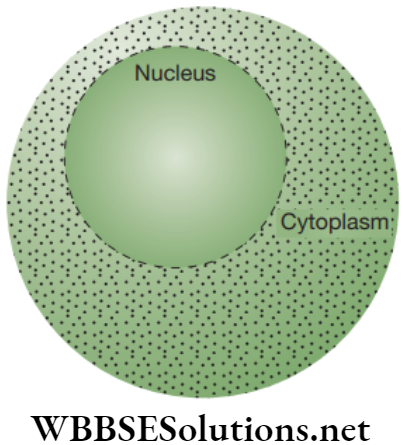
Endoplasmic Reticulum (ER)
ER is a membranous network enclosing a fluid-filled lumen that almost fills up the intracellular cavity. ER is connected to the outer membrane of the nucleus at one end, whereas the other end is connected to the plasma membrane. ER occurs in the form of three parts, namely cisternae (closed, fluid-filled sacs), vesicles and tubules.
There are two types of ER and they are explained as follows.
Rough endoplasmic reticulum (RER): Ribosomes are attached on its surface for protein synthesis.
Smooth endoplasmic reticulum (SER): No ribosomes are attached and it helps in secreting lipids.
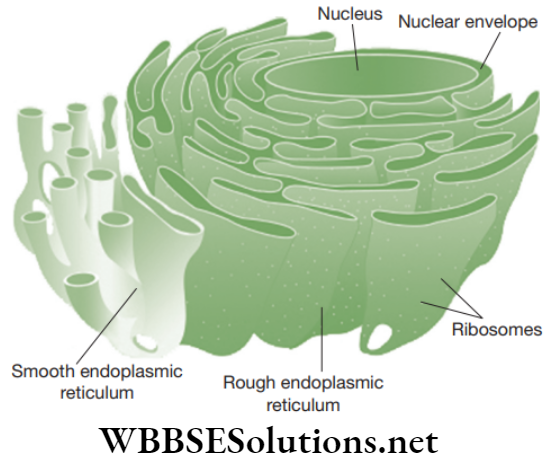
Functions of ER
- ER acts as a supporting skeletal framework for the cell.
- ER helps in the passage of nuclear material between the adjoining cells.
- RER helps in the synthesis of proteins by ribosomes on their surface.
- In vertebrates, SER of liver helps in detoxification of various toxic or poisonous substances that enter the animal’s body through food, air or water.
- SER is involved in the biosynthesis of glycolipids, phospholipids and cholesterol.
- SER is involved in the synthesis of steroid hormones, like estrogen, testosterone and cortisol.
- RER produces hydrolytic enzymes of lysosomes. From RER, the hydrolytic enzymes are transported to Golgi apparatus where it gets included into lysosome.
- ER helps in the formation of plasma membrane and other cellular membranes. SER produces lipid molecules for cell membrane and gets inserted into SER membrane. RER is involved in the synthesis of protein molecules of cell membrane. In the process of glycosylation, small chains of sugars known as oligosaccharides are added to molecules of proteins and lipids at the level of Golgi apparatus.
Ribosomes
Ribosomes are dense, spherical and granular particles that are present freely in the cytosol or it remains studded to the RER. Ribosomes mainly consist of the ribonucleic acid (RNA) and proteins. Ribosomes are not bounded by membranes.
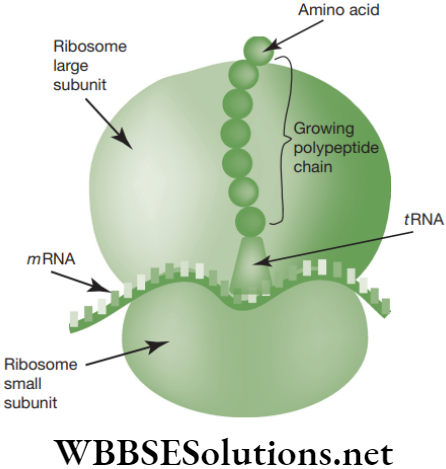
Function of Ribosomes
- Ribosomes play a crucial role in the synthesis of proteins.
- These are considered to be the factories of protein in a cell. Actually, one ribosome cannot perform protein synthesis.
- In 1963, Gric and Hall published the detailed role of polyribosome in protein synthesis and showed that active units are no individual ribosome, instead a group of these units are known as polyribosomes.
Types of Ribosomes
Basically, there are two types of ribosomes, such as 70S and 80S ribosomes. Here, S denotes Svedberg unit, which is the sedimentation coefficient that depicts how fast cell organelle sediments in an ultracentrifuge. Sedimentation coefficients cannot be additive.
80S ribosomes occur in eukaryotes, such as algae, fungi, higher plants and animals. In animals, the 80S ribosome is made up of a large 60S subunit and a small 40S subunit.
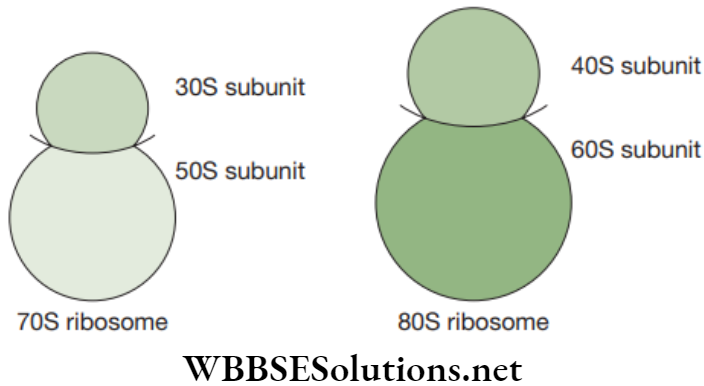
70S ribosomes are comparatively smaller and occur in prokaryotes such as bacteria. The 70S ribosomes are made up of a large 50S subunit and a small 30S subunit.
Interestingly, ribosomes found in mitochondria and chloroplasts of eukaryotes resemble to the ribosomes of prokaryotes and not to the 80S eukaryotic ribosomes.
Golgi Apparatus
Golgi apparatus is an arrangement of membrane-bounded, fluid-filled vesicles, vacuoles and flattened cisternae (closed sacs). Golgi apparatus originates from the membrane of the SER that in turn has originated from RER.
The proximal Golgi saccules (cisterna at cis face) are produced by fusion of ER-derived vesicles, whereas distal saccules (cisternae at trans face) are fully used for vesicle formation and vanish. Hence, Golgi saccules are renewed constantly and speedily.
Generally, the cisternae are stacked together in parallel. There are two faces of Golgi apparatus, such as Cis face of Golgi, where cisternae are formed and trans face of Golgi, where vesicles are budded off.
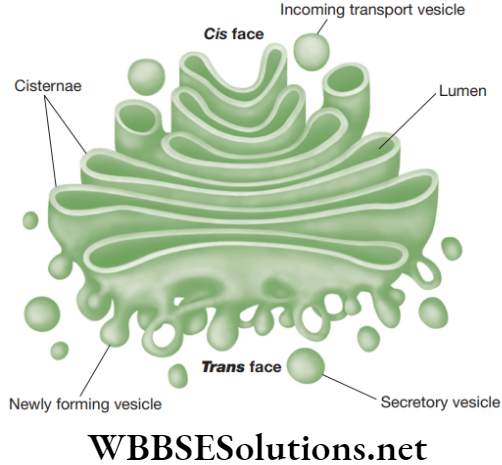
Functions
- Golgi apparatus acts as an assembly area for the storage, processing and packaging of various cellular secretions.
- It is involved in the synthesis of cell wall, plasma membrane and lysosomes.
Lysosomes
Lysosomes are small, spherical, single membrane-bound, sac-like structures uniformly distributed in the cytoplasm and it consists of digestive enzymes. These lysosomal enzymes are produced by RER.
Functions
- Lysosomes act as intracellular digestive system by destroying any foreign material that enters the cell and hence, these are called digestive bags. By doing this, they protect the cells from any harmful effect of foreign material such as from bacterial infection.
- Lysosomes remove the worn out cellular organelles by digesting them so that new replacements are done. By doing this, they remove the cell debris. Thus, lysosomes act as a type of garbage disposal system of the cell. These are also known as demolition squads, scavengers and cellular housekeepers.
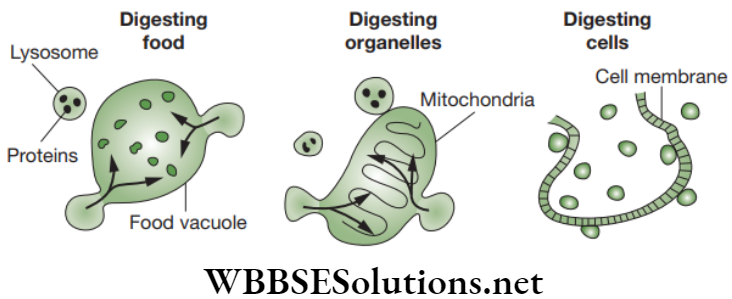
- At the time of breakdown of cell structure, lysosomes may burst and the enzymes released eat up their own cells. Thus, lysosomes are also known as suicidal bags of a cell.
Mitochondria
The mitochondria are small bodies of varying shapes and size distributed in the cytoplasm. Each mitochondrion is enclosed in a double-membrane envelope. Outer membrane is having pores, whereas the inner membrane is thrown into folds called cristae, which are studded with tiny rounded bodies called F1 particles or oxysomes.
The internal cavity of the mitochondria is filled with a proteinaceous gel-like matrix that contains some smallsized ribosomes, a circular DNA molecule and phosphate granules.
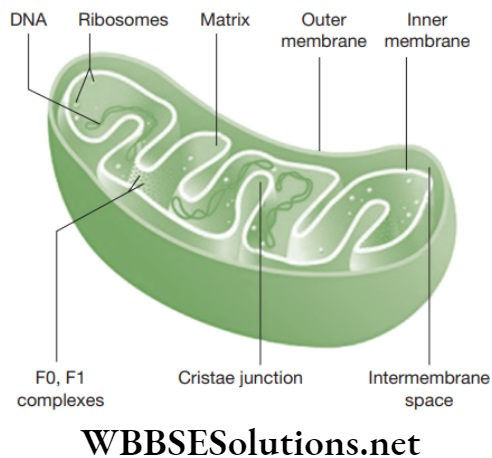
Functions
- Mitochondria serve as the sites for cellular respiration. They utilize molecular oxygen from air to oxidize the carbohydrates and fats present in the cell to carbon dioxide and water vapour. Energy is released during oxidation and some part of this energy is used to form ATP (adenosine triphosphate). As mitochondria synthesizes energy-rich compounds hence they are called ’power house’ of the cell.
- Mitochondria can synthesize some of their own proteins, and DNA, due to which they are also considered as semi-autonomous organelles.
Plastids
Plastids are present in most of the plant cells, but absent in animal cells. The plastids have their own DNA and ribosomes and so they are self-replicating organelles similar to mitochondria. Plastids are mainly of three types and they are listed below.
- Chromoplasts: Coloured plastids (excluding green colour)
- Chloroplasts: Green-coloured plastids
- Leucoplasts: Colourless plastids
Functions
- Chloroplasts help in photosynthesis in which they manufacture food for the plant by trapping solar energy. These are called ‘kitchens of the cells’.
- Chromoplasts impart various colours to flowers and some leaves that helps in attracting the insects for pollination.
- Leucoplasts stores food in the form of starch, fats and protein.
Chloroplasts
Chloroplasts consist of a green pigment called chlorophyll, which helps in photosynthesis. Each chloroplast is enveloped by two unit membranes (Fig. 1.23). The two separate regions shown in the chloroplast are as follows.
- Grana are stacks of membrane-bounded, flattened discoid sacs (known as thylakoids) consisting of the chlorophyll molecules. These are the main functional units of chloroplasts. This is the site of light reaction during photosynthesis.
- Stroma is the homogeneous matrix in which grana are embedded. Stroma consists of various photosynthetic enzymes, starch grains, DNA and ribosomes. This is the site of dark reaction during photosynthesis.
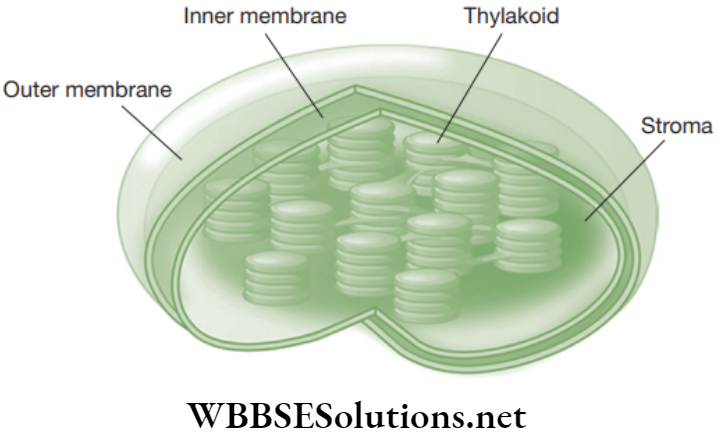
Vacuoles
Vacuoles are fluid-filled or solid-filled; usually single membrane-bounded spaces. In animal cells, the vacuoles are rare, small and temporary. They store water, glycogen and proteins. Vacuoles serve as osmoregulatory organelles in protozoans and ingestion of nutrient material in amoeba and paramecium.
In plant cells, the vacuoles are large, distinct and permanent. In mature plant cells, the vacuole occupies almost 90 per cent volume of the cell and takes a central position. Due to this, the nucleus and other cell organelles are pushed near the cell wall. The vacuole is bounded by a membrane known as tonoplast and filled with a water solution called the cell sap.
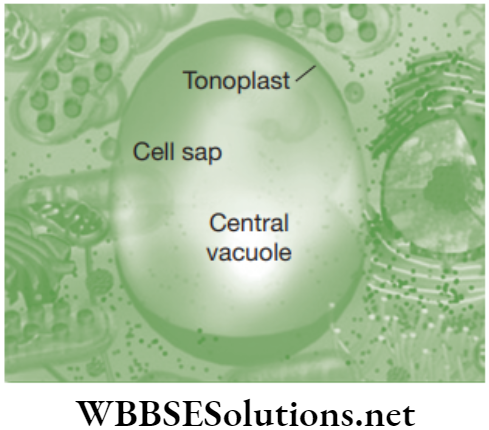
Functions
- Vacuoles maintain the osmotic pressure in a cell.
- Vacuoles store toxic metabolic by-products or end products of plant cells.
- Vacuoles give turgidity and rigidity to the plant cells.
Peroxisomes
Peroxisomes are minute, single membrane-bounded, spherical organelles consisting of powerful oxidative enzymes. In peroxisomes, the inner contents are finely granular, but at times a crystalline core is visible by transmission electron microscope in the centre of peroxisomes.
This crystalline core is a crystallized protein known as catalase enzyme. Peroxisomes are usually found in kidney and liver cells.
Peroxisomes consists of catalase enzyme that catalyses the decomposition of hydrogen peroxide to water and oxygen. This gives the name ‘peroxisome’. As hydrogen peroxide is a by-product of some cell oxidations and is also highly toxic, so it must be eliminated from the cell.
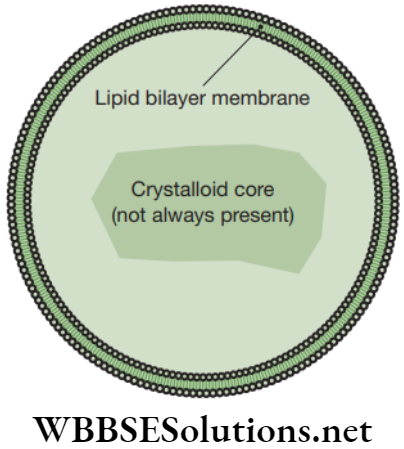
Functions
Peroxisomes carry out some oxidative reactions like detoxification or removal of toxic substances from the cell.
Centrosome
Centrosome consists of two granule-like centrioles and it is not covered by any membrane. Centrioles are hollow and cylindrical structures that are made up of microtubules. Centrosomes are present only in animal cells. In plant cells, the polar caps perform functions similar to that of the centrioles.
Functions
Centrosome is involved in cell division in animal cells. At the time of cell division, centrioles move to the poles of cells and helps in the formation of spindle.
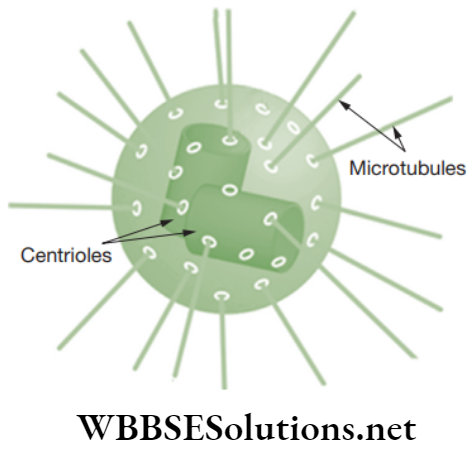
Chapter 1 The Fundamental Unit Of Life Master Your Test Question And Answers
Question 1. Name the following.
(a) Outer most layer of the cell wall connecting the two adjoining cells.
(b) Cell membrane is chemically made up of
(c) Fold of plasma membrane in bacterial cells.
(d) Component which is considered as dynamic part of cell.
(e) What happens to cell when placed in salt solution?
(f) Who proposed fluid mosaic model?
Answer: (a) Middle lamella (b) protein (c) mesosomes (d) nucleus (e) cell swells (f) S. J. Singer and G. L. Nicolson (1972)
Question 2. Define phagocytosis.
Answer: Intake of solid material by evagination of cell membrane on the periphery is known as phagocytosis.
Question 3. Define active transport.
Answer: Active transport is a speedy process. Diffusion is a slow process. This transport can move substances through a biological membrane against the concentration gradient and it is unidirectional in nature.
Question 4. Define exocytosis.
Answer: Exocytosis is the process by which the intracellular vesicles in the cytoplasm fuse with the plasma membrane and release their contents into the surrounding medium.
Question 5. Differentiate between diffusion and osmosis.
Answer:
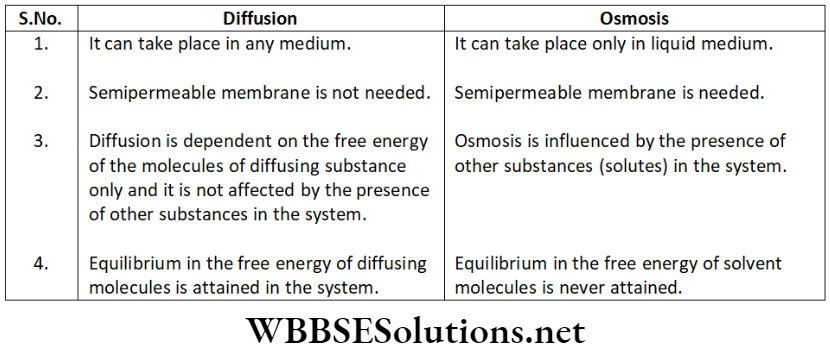
Chapter 1 The Fundamental Unit Of Life Track Your Learning Questions and Answers
Question 1. Which of the following organelle is known as ‘suicidal bags’?
- Peroxisomes
- Lysosomes
- Endosomes
- Vacuoles
Answer. 2. Lysosomes
Question 2. Name the ‘powerhouse of the cell’.
- Chloroplast
- Chromoplast
- Mitochondrion
- Endoplasmic reticulum
Answer. 3. Mitochondrion
Question 3. In plant cells, Golgi apparatus is known as
- Dictyosomes
- Autosomes
- Oxisomes
- Golgi bodies
Answer. 1. Dictyosomes
Question 4. Light reaction of photosynthesis takes place in which part of chloroplast?
- Stroma
- Grana
- Cristae
- F1 particles
Answer. 2. Grana
Question 5. ______ serve as osmoregulatory organelles in protozoans.
- Vacuoles
- Vesicles
- Lumen
- Saccules
Answer. 1. Vacuoles
Question 6. Which one of the following has its own DNA?
- Mitochondria
- Dictyosome
- Lysosome
- Peroxisome
Answer. 1. Mitochondria
Question 7. The main arena of various types of activities of a cell is
- Plasma membrane
- Mitochondrion
- Cytoplasm
- Nucleus
Answer. 3. Cytoplasm
Question 8. In mitochondria, protons accumulate in the
- Outer membrane
- Inner membrane
- Intermembrane space
- Matrix
Answer. 3. Intermembrane space
Question 9. Which one of the following is not considered as a part of the endo-membrane system?
- Golgi complex
- Peroxisome
- Vacuole
- Lysosome
Answer. 2. Peroxisome
Question 10. Which one of the following organisms is not an example of eukaryotic cells?
- Escherichia coli
- Euglena viridis
- Amoeba proteus
- Paramecium caudatum
Answer. 1. Escherichia coli
Chapter 1 The Fundamental Unit Of Life Practice Exercises
NCERT Exemplar
Question 1. Which of the following can be made into crystal?
- A bacterium
- An amoeba
- A virus
- A sperm
Answer. 3. A virus
Question 2. A cell will swell up if
- The concentration of water molecules in the cell is higher than the concentration of water molecules in surrounding medium.
- The concentration of water molecules in surrounding medium is higher than water molecules concentration in the cell.
- The concentration of water molecules is same in the cell and in the surrounding medium.
- Concentration of water molecules does not matter.
Answer. 2. The concentration of water molecules in surrounding medium is higher than water molecules concentration in the cell.
Question 3. Chromosomes are made up of
- DNA
- Protein
- DNA and protein
- RNA
Answer. 3. DNA and protein
Question 4. Which of these options are not a function of ribosomes?
(1) It helps in the manufacture of protein molecules.
(2) It helps in the manufacture of enzymes.
(3) It helps in the manufacture of hormones.
(4) It helps in the manufacture of starch molecules.
- (1) and (2)
- (2) and (3)
- (3) and (4)
- (4) and (1)
Answer. 3. (3) and (4)
Question 5. Which of these is not related to endoplasmic reticulum?
- It behaves as transport channel for proteins between nucleus and cytoplasm.
- It transports materials between various regions in cytoplasm.
- It can be the site of energy generation.
- It can be the site for some biochemical activities of the cell.
Answer. 3. It can be the site of energy generation.
Question 6. Following are a few definitions of osmosis, soread carefully and select the correct definition.
- Movement of water molecules from a region of higher concentration to a region of lower concentration through a semipermeable membrane.
- Movement of solvent molecules from its higher concentration to lower concentration.
- Movement of solvent molecules from higher concentration to lower concentration of solution through a permeable membrane.
- Movement of solute molecules from lower concentration to higher concentration of solution through a semipermeable membrane.
Answer. 1. Movement of water molecules from a region of higher concentration to a region of lower concentration through a semipermeable membrane.
Question 7. Plasmolysis in a plant cell is defined as
- Breakdown (lysis) of plasma membrane in hypotonic medium.
- Shrinkage of cytoplasm in hypertonic medium.
- Shrinkage of nucleoplasm
- None of the above
Answer. 2. Shrinkage of cytoplasm in hypertonic medium.
Question 8. Which of the following is covered by a single membrane?
- Mitochondria
- Vacuole
- Lysosome
- Plastid
Answer. 2. Vacuole
Question 9. Find out the false sentence.
- Golgi apparatus is involved with the formation of lysosomes.
- Nucleus, mitochondria and plastid have DNA and hence, they are able to make their own structural proteins.
- Mitochondria is said to be the power house of the cell as ATP is generated in them.
- Cytoplasm is known as protoplasm.
Answer. 1. Golgi apparatus is involved with the formation of lysosomes.
Question 10. Find out the correct sentence.
- Enzymes packed in lysosomes are made through RER (rough endoplasmic reticulum).
- Rough endoplasmic reticulum and smooth endoplasmic reticulum produce lipid and protein, respectively.
- Endoplasmic reticulum is related with the destruction of plasma membrane.
- Nucleoid is present inside the nucleoplasm of eukaryotic nucleus.
Answer. 1. Rough endoplasmic reticulum and smooth endoplasmic reticulum produce lipid and protein, respectively.
Question 11. Which cell organelle plays a crucial role in detoxifying many poisons and drugs in a cell?
- Golgi apparatus
- Lysosomes
- Smooth endoplasmic reticulum
- Vacuoles
Answer. 3. Smooth endoplasmic reticulum
Question 12. The proteins and lipids, essential for building the cell membrane are manufactured by
- Rough endoplasmic reticulum
- Golgi apparatus
- Plasma membrane
- Mitochondria
Answer. 1. Rough endoplasmic reticulum
Question 13. The undefined nuclear region of prokaryotes are also known as
- Nucleus
- Nucleolus
- Nucleic acid
- Nucleoid
Answer. 4. Nucleoid
Question 14. The cell organelle involved in forming complex sugars from simple sugars are
- Endoplasmic reticulum
- Ribosomes
- Plastids
- Golgi apparatus
Answer. 4. Golgi apparatus
Question 15. Which out of the following is not a function of vacuole?
- Storage
- Providing turgidity and rigidity to the cell.
- Waste excretion
- Locomotion
Answer. 4. Locomotion
Question 16. Amoeba acquires its food through a process, termed as
- Exocytosis
- Endocytosis
- Plasmolysis
- Exocytosis and endocytosis
Answer. 2. Endocytosis
Question 17. The cell wall of which one of these is not made up of cellulose?
- Bacteria
- Hydrilla
- Mango tree
- Cactus
Answer. 1. Bacteria
Question 18. Silver nitrate solution is used to study
- Endoplasmic reticulum
- Golgi apparatus
- Nucleus
- Mitochondria
Answer. 2. Golgi apparatus
Question 19. Organelle other than nucleus, containing DNA is
- Endoplasmic reticulum
- Golgi apparatus
- Mitochondria
- Lysosome
Answer. 3. Mitochondria
Question 20. Kitchen of the cell is
- Mitochondria
- Endoplasmic reticulum
- Chloroplast
- Golgi apparatus
Answer. 3. Chloroplast
Question 21. Lipid molecules in the cell are sythesized by
- Smooth endoplasmic reticulum
- Rough endoplasmic reticulum
- Golgi apparatus
- Plastids
Answer. 1. Smooth endoplasmic reticulum
Question 22. Cell arising from pre-existing cell was stated by
- Haeckel
- Virchow
- Hooke
- Schleiden
Answer. 2. Virchow
Question 23. Cell theory was given by
- Schleiden and Schwann
- Virchow
- Hooke
- Haeckel
Answer. 1. Schleiden and Schwann
Question 24. The only cell organelle seen in prokaryotic cell is
- Mitochondria
- Ribosomes
- Plastids
- Lysosomes
Answer. 2. Ribosomes
Question 25. Organelle without a cell membrane is
- Ribosome
- Golgi apparatus
- Chloroplast
- Nucleus
Answer. 1. Ribosome
Question 26. 1 μm is
- 10-6 m
- 10-9 m
- 10-10 m
- 10-3 m
Answer. 1. 10-6 m
Question 27. Lysosome arises from
- Endoplasmic reticulum
- Golgi apparatus
- Nucleus
- Mitochondria
Answer. 2. Golgi apparatus
Question 28. Living cells were discovered by
- Robert Hooke
- Purkinje
- Leeuwenhoek
- Robert Brown
Answer. 3. Leeuwenhoek
Question 29. Select the odd one out from the following.
- The movement of water across a semipermeable membrane is affected by the amount of substances dissolved in it.
- Membranes are made of organic molecules like proteins and lipids.
- Molecules soluble in organic solvents can easily pass through the membrane.
- Plasma membranes contain chitin sugar in plants.
Answer. 4. Plasma membranes contain chitin sugar in plants.
Chapter 1 The Fundamental Unit Of Life Classroom Corner
Fill in the Blanks
Question 1. Scientist credited with the discovery of cell __________.
Answer. Robert Hooke
Question 2. World’s largest single-celled organism __________.
Answer. Caulerpa taxifolia
Question 3. Largest cell in the human body __________.
Answer. Ovum
Question 4. Smallest cell in the human body __________.
Answer. Sperms
Question 5. Proposed cell theory in animals __________.
Answer. Theodor Schwann in 1839
Question 6. Father of microbiology __________.
Answer. Anton van Leeuwenhoek
Question 7. Energy stored in mitochondria is in the form of __________.
Answer. ATP (Adenosine triphosphate)
Question 8. Groups of ribosomes in the cell __________.
Answer. Polysomes
Question 9. Plastids present in flowers and fruits _______.
Answer. Leucoplasts
Question 10. Considered as kitchen of cell __________.
Answer. Chloroplasts
Chapter 1 The Fundamental Unit Of Life Match The Columns
Question 1.
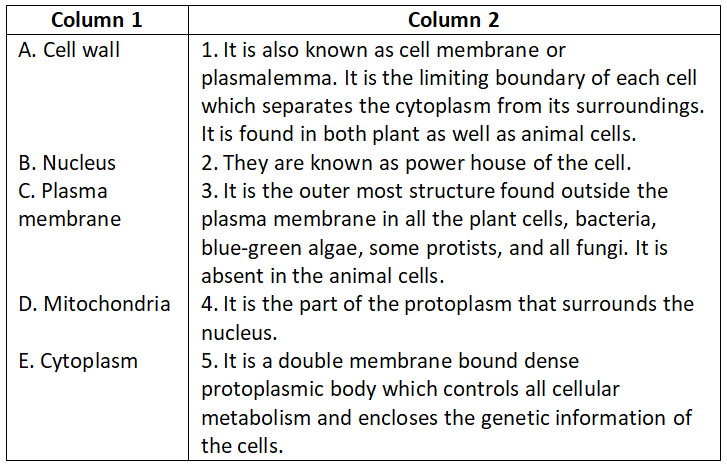
- A-3, B-5, C-1, D-2, E-4
- A-1, B-2, C-3, D-4, E-5
- A-5, B-4, C-3, D-2, E-1
- A-4, B-1, C-2, D-5, E-3
Answer. 1. A-3, B-5, C-1, D-2, E-4
Question 2.
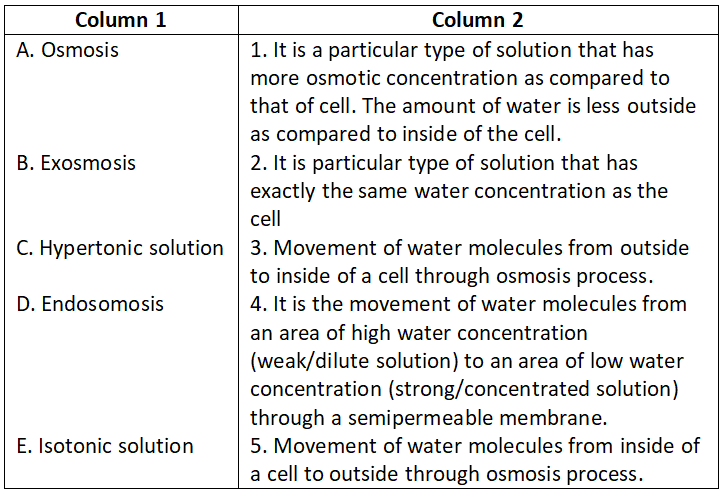
Select the correct option.
- A-1, B-2, C-3, D-4, E-5
- A-5, B-4, C-3, D-2, E-1
- A-4, B-5, C-1, D-3, E-2
- A-5, B-3, C-1, D-4, E-2
Answer. 3. A-4, B-5, C-1, D-3, E-2
Question 3.

Select the correct option.
- A-3, B-2, C-3, D-1, E-5
- A-5, B-4, C-1, D-2, E-3
- A-4, B-5, C-1, D-3, E-2
- A-4, B-3, C-1, D-5, E-2
Answer. 3. A-4, B-5, C-1, D-3, E-2
Question 4.

Select the correct option.
- A-1, B-2, C-3, D-4, E-5
- A-5, B-4, C-1, D-2, E-3
- A-4, B-5, C-1, D-3, E-2
- A-4, B-5, C-3, D-1, E-2
Answer. 3. A-4, B-5, C-1, D-3, E-2
Question 5.

Select the correct option.
- A-1, B-2, C-3, D-4
- A-1, B-4, C-3, D-2
- A-3, B-4, C-1, D-2
- A-2, B-4, C-3, D-1
Answer. 3. A-3, B-4, C-1, D-2

